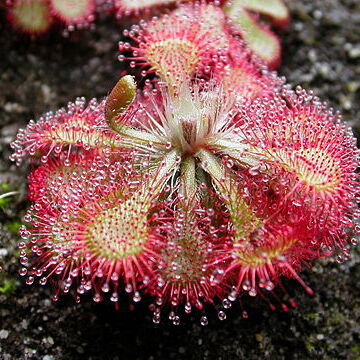Perennial or annual herbs with rhizomes, fibrous roots, or tubers with a vertical underground stolon. Stems extremely short, or long and erect, or climbing and up to 1.5 m long. Leaves all rosetted, rosetted and cauline, or all cauline, the adaxial surface or the whole lamina covered with glandular trichomes which trap insects, rarely leaves glabrous; cauline leaves scattered, or in groups of 3 with two lateral (secondary) leaves arising from the axil of a long-petiolate primary leaf. Flowers bisexual, actinomorphic. Sepals and petals 5, rarely 4 or 8 (petals rarely up to 12), free or the sepals shortly united at base. Stamens as many as petals. Ovary superior, 1–locular. Styles 2–5, simple, once, twice, or repeatedly divided. Fruit a loculicidal capsule. Seeds numerous, ellipsoidal or linear, sometimes winged.
Low insectivorous herbs. Leaves alternate, usually in basal rosettes, covered with glandular hairs having viscid secretion; blades filiform to broadly orbicular, circinate in bud; stipules scarious, variously fringed or divided, adnate or free. Inflorescences circinate, nodding at the underdeveloped apex. Flowers regular, hypogynous, generally pentamerous; sepals 4-8, usually 5, withering-persistent, distinct or mostly united at the base, imbricate; petals 4-8, usually 5, white, pink or purple, broadened at the tip, distinct or slightly united at the base; stamens 4-8, as many as the petals, the filaments subulate or filiform, the anthers slightly extrorse and versatile; ovary superior, sessile, 1-celled, many-ovuled, the placentas
Herbs perennial or annual, with rhizomes, fibrous roots, or tubers with a vertical stolon below ground. Stem very short, long and erect, or climbing. Leaves basal and rosulate, or alternate, petiolate, with glandular, papillose hairs. Flowers bisexual, actinomorphic. Sepals (4 or)5(or 6-12), free or connate at base, persistent. Petals 5, free, closing and contorted after anthesis, persistent. Stamens as many as petals. Ovary superior, 1-loculed, 2-5-carpellate; placentation parietal; styles (2 or)3-5(or 6), free or connate at base, persistent. Capsule dehiscent, 2-6-valved. Seeds numerous, ellipsoid or linear, sometimes winged.
Mostly perennial, often stemless, often with a subterranean tuber. Leaves with glandular, irritable, capitate tentacles. Stipules present or absent, often split. Flowers in simple (or branched), bracteate inflorescences (in extra-Mal. spp. sometimes solitary), white, pink, or purple, 5(-4)-merous. Sepals imbricate, connate at the base. Petals in Mal. spp. 5, spathulate or obovate, marcescent, after anthesis contracted and sticking together with the anthers and stigmas as a hood over the ovary and the capsule. Carpels 3-5; styles 3-5, free or connate at the base, often divided in various ways.
Plants annual or perennial [rarely subshrubs], deciduous, stems 1–2 cm (except also caulescent stems to 8(–20) cm in D. intermedia), usually forming over-wintering buds (hibernaculae). on both surfaces in strong sunlight, greener in shade (except D. tracyi, which lacks red pigment even in full sun), unlobed, suborbiculate, orbiculate, spatulate, or obovate, or cuneate to linear pink, or rose to pinkish lavender; stamens 5, usually connate basally; gynoecium 3-carpellate; styles 3, deeply bifid; stigma capitate. Capsules obovoid, splitting between placentae. Seeds 20–70, <minute>. x = 10.
Sepals 5 or 4 or 8, connate at base or gamosepalous; petals and stamens same number as sepals; carpels 3-5. Capsule loculicidally 3-5-valved; style branches 3-5, often again divided; seeds ∞ . Herbs or subshrubs, mostly perennial, furnished with irritable glandular hairs. Subcosmopolitan genus with some 100 spp., well developed in Australia. Five of the N.Z. spp. occur in Australia and Tasmania. D. spathulata extends to Malaya, China and southern Japan. D. stenopetala is endemic to N.Z.
Mostly perennial herbs. Leaves in a basal rosette or in whorls, the blades provided with sticky glands which in most species are situated towards the margin of the upper surface and which trap small insects. Inflorescence 1–many-flowered, racemose or cymose. Sepals and petals usually 5, rarely 4 or 8. Stamens 5–20. Ovary of 3–5 carpels; styles 3–5. Fruit a capsule with 3–5 valves. Seeds small and numerous.
Pet white, pink, or purple, broadened distally; stamens 4–8, as many as the pet; styles usually 3, bipartite to the base; ovules in 2–5 rows on each placenta; capsule usually 3-valved; testa loose; lf-blades filiform to peltate; stipules scarious, variously fringed or divided, or rarely wanting; infl a sympodial cyme, nodding at the undeveloped tip.100, widespread.
3-5, parietal, the ovules subglobose or ovoid in 2-5 rows on each placenta, anatro-pous, the styles 2-5, usually 3, often bifurcate to the base or branched. Capsules 2-5-valved, usually 3-valved; seeds minute, numerous, usually stipitate, the testa variously reticulated and ornamented.
Annual or perennial insectivorous herbs, caulescent or acaulescent, with pseudo-roots on which tubers are sometimes formed.
Leaves in a basal rosette or caulescent and alternate, the lamina provided with sticky glands which trap small insects.
Ovary 3–5-carpellary; styles 3–5; ovules on 3–5 parietal placentas.
Stamens the same number as the petals, and alternating with them
Inflorescence 1-to many-flowered, racemose or cymose.
Sepals, petals and stamens usually 5, rarely 4–8.
Herbs with sticky glandular hairs
Sepals and petals 5 (rarely 4-8)
Seeds small and numerous.
Placentas 3-5

